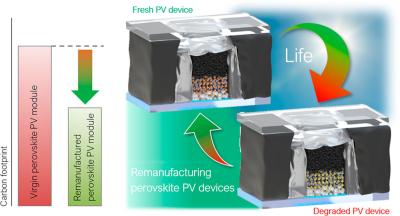![]() EPFL is a Switzerland-based technical university and research center. EPFL is focused on three missions: teaching, research and technology transfer.
EPFL is a Switzerland-based technical university and research center. EPFL is focused on three missions: teaching, research and technology transfer.
EPFL works together with an extensive network of partners including other universities and institutes of technology, secondary schools and colleges, industry and economy, political circles and the general public.
EPFL does extensive perovskite R&D work and is responsible for many publications and advancements in the field.
Route Cantonale
1015 Lausanne
Switzerland
Researchers develop a crystal capping layer to enable the formation of black-phase FAPbI3 perovskites in humid air
Researchers from Peking University, Tsinghua University, Beijing Institute of Technology and Ecole Polytechnique Fédérale de Lausanne (EPFL) have tackled a reproducibility challenge in black-phase formamidinium lead iodide (α-FAPbI3) perovskites. They explained that while this is the desired phase for photovoltaic applications, water can trigger formation of photoinactive impurity phases such as δ-FAPbI3. The team found that the classic solvent system for perovskite fabrication exacerbates this reproducibility issue.
Growth of the photoactive black phase of formamidinium lead iodide (α-FAPbI3) usually requires dimethyl sulfoxide solvent, but the hygroscopic nature of this chemical also promotes water-induced degradation to the photoinactive phase. the scientists showed that a larger chlorinated organic molecule can form a hydrophobic capping layer that enables perovskite crystallization under humid conditions by protecting growing crystallites from water.
Researchers use machine learning to accelerate the discovery of perovskite materials
Researchers at EPFL, Shanghai University and Université catholique de Louvain recently developed a method based on machine-learning to quickly and accurately search large databases, leading to the discovery of 14 new materials for solar cells.
The research project, led by EPFL's Haiyuan Wang and Alfredo Pasquarello, developed a method that combines advanced computational techniques with machine-learning to search for optimal perovskite materials for photovoltaic applications. The approach could lead to more efficient and cheaper solar panels, transforming solar industry standards.
Researchers use synergetic substrate and additive engineering to achieve over 30%-efficient perovskite-Si tandem solar cells
Researchers from EPFL, CSEM and Empa have demonstrated a cell design combining additive and substrate engineering that yields consistently high power conversion efficiencies and discussed various design aspects that are important for reproducibility and performance.
The team presented two key developments with a synergetic effect that boost the PCEs of tandem devices with front-side flat Si wafers—the use of 2,3,4,5,6-pentafluorobenzylphosphonic acid (pFBPA) in the perovskite precursor ink that suppresses recombination near the perovskite/C60 interface and the use of SiO2 nanoparticles under the perovskite film that suppress the enhanced number of pinholes and shunts introduced by pFBPA, while also allowing reliable use of Me-4PACz as a hole transport layer.
Researchers use dopant-additive synergism to develop perovskite solar module with efficiency of 23.3%
Researchers from EPFL, Soochow University, Chinese Academy of Sciences, Lomonosov Moscow State University, Luxembourg Institute of Science and Technology (LIST), Julius Maximilian University of Würzburg, Toin University of Yokohama, Southern University of Science and Technology, Xi’an Jiaotong University, North China Electric Power University and Toyota Motor Europe recently developed a solar panel relying on EPFL's record-breaking 25.32%-efficient 2D/3D perovskite solar cells unveiled in July 2023.
The group's research demonstrates a larger surface area of 27.22 cm2, achieving an impressive efficiency of 23.3%. In the paper, the scientists explain that the module's high efficiency was achieved thanks to a synergistic dopant-additive combination strategy aimed to improve the cell absorber's uniformity and crystallinity. They used, in particular, methylammonium chloride (MACl) as a dopant and a Lewis-basic ionic liquid known as 1,3-bis(cyanomethyl)imidazolium chloride ([Bcmim]Cl) as an additive.
Researchers develop method for re-manufacturing perovskite solar cells and modules
An international group o researchers, including ones from the Fraunhofer Institute for Solar Energy Systems ISE, Solaronix, University of Cambridge, École Polytechnique Fédérale de Lausanne (EPFL) and others, have developed a method to re-manufacture fully encapsulated perovskite solar cells after recycling. According to the researchers, the re-manufactured devices can achieve 88% of their original efficiency.
The novel method for re-manufacturing perovskite solar cells (PSCs) uses carbon-based electrodes (CPSMs). Re- manufacturing, as opposed to merely recycling, is described as the combination of re-used, recycled, repaired, or replaced parts to make a new product. “In this work, we demonstrate for the first time a re-manufacturing strategy for glass-glass encapsulated perovskite solar cells,” the scientists stated. “Our study presents a facile experimental method to remove the edge-sealant, encapsulant, back electrode, and degraded perovskite, allowing reuse of the device constituents.”
Pagination
- Page 1
- Next page




